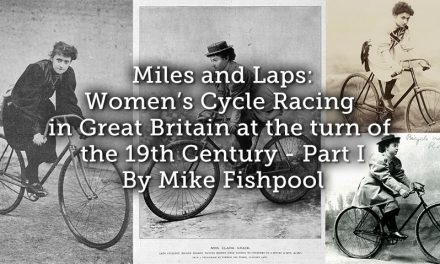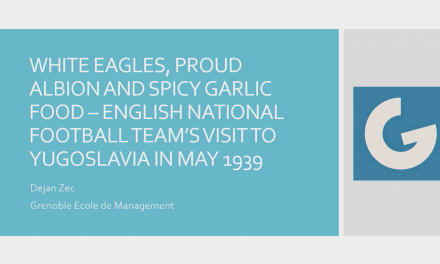All images are published on the permission by Paolo Gilardi (Archivio privato Marta Boccalini, including all photos of Rosetta’s football notebook), Francesco and Luigi Ferrari (Archivio privato Giovanna Boccalini Barcellona) and Franceco Bacigalupo (Archivio privato Brunella Bracardi).
PLEASE NOTE: Any reproduction of images is forbidden. Please contact the Playing Pasts Editor for more details
To read the previous articles in this series please see the links below –
Part 1: Part 2: Part 3: Part 4: Part 5: Part 6: Part 7: Part 8: Part 9: Part 10:
In 2017 I published the first two academic articles about the history of Gruppo Femminile Calcistico (GFC). In Summer 2019, while all people in Italy was finally noticing the existence of women’s football in the country (thanks to the stunning performance of the azzurre at the Women’s World Cup in France), Corriere della Sera journalist interviewed me about my research: after that meeting, we started to write the Giovinette book, which was released in Summer 2020. The book comprised of an historical novel written by Federica, and then an historical essay written by me, Giovinette had been very useful in reaching a large audience and telling the hidden story of the Milanese women’s footballers who started to play in 1933. One of the greatest results of the book was that, thanks to councilwoman Anita Pirovano (an amateur footballer herself), on 24th September 2020 the Municipality of Milan decided to name a street after the GFC team: ‘Via Calciatrici del ’33’. Due to the pandemic situation, the ceremony was postponed twice: finally, on June 12th 2021, a lovely sunny morning, we all gathered in front of the Arena Civica …
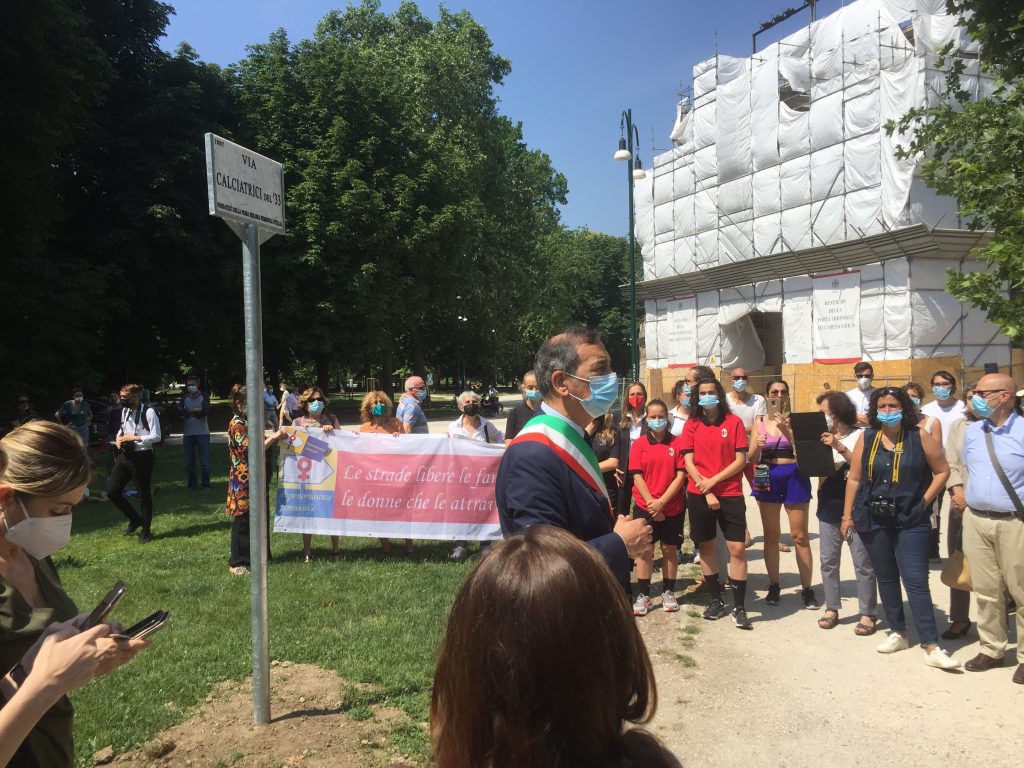
In the background, the Arena Civica (under restauration), the stadium were many of the GFC founders used to attend Ambrosiana-Inter games in the early 1930s’
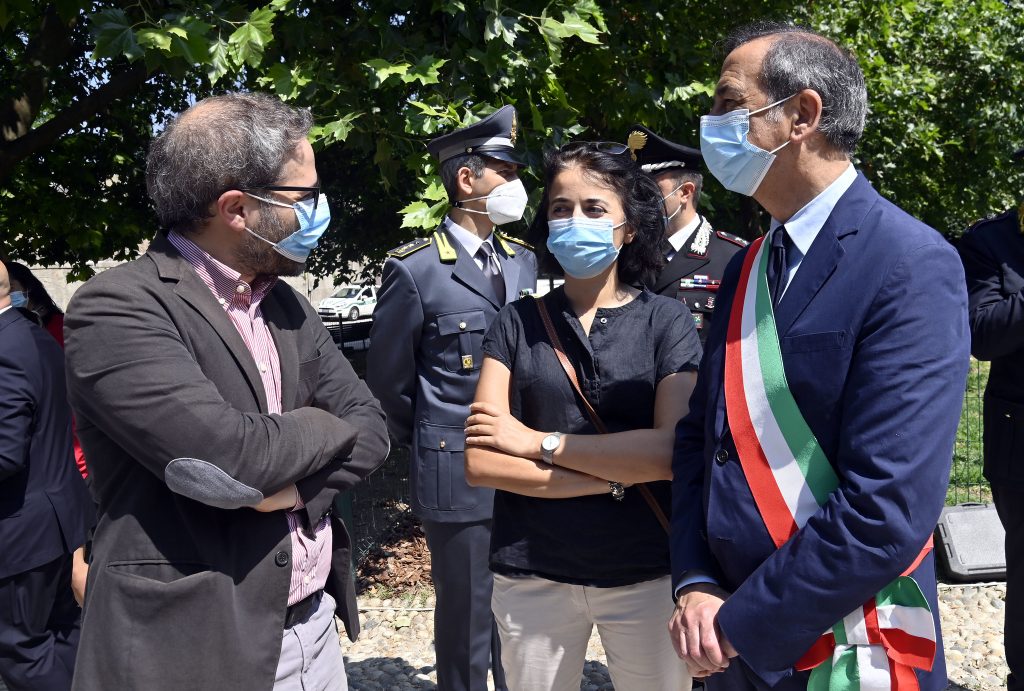
Federica and myself in conversation with Mayor Beppe Sala
Source: https://flic.kr/p/2m55z3L
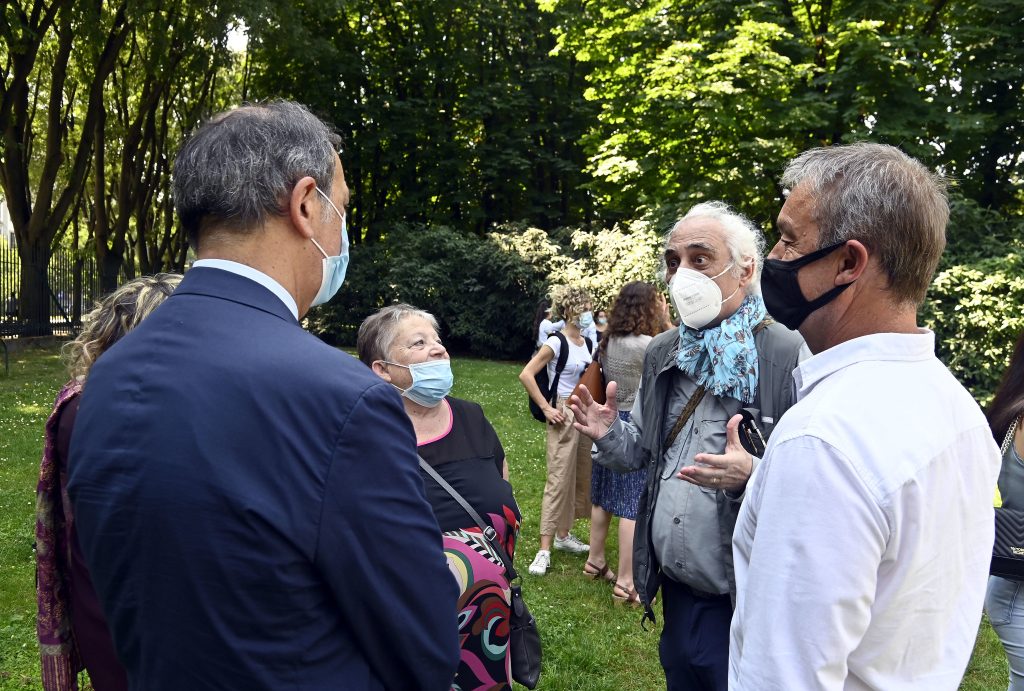
Mayor Sala talking with three heirs of Boccalini’s sisters
Rosa Mottino (Luisa’s daughter), Paolo Gilardi (Rosetta’s son) and Marco Bonitta (Luisa’s grandson)
Source: https://flic.kr/p/2m59WAu
In Italy very few streets are named after sportswomen: Via Calciatrici del ’33 is both the first dedicated to women’s football, and to a group of sportswomen, rather than a single sportswoman.
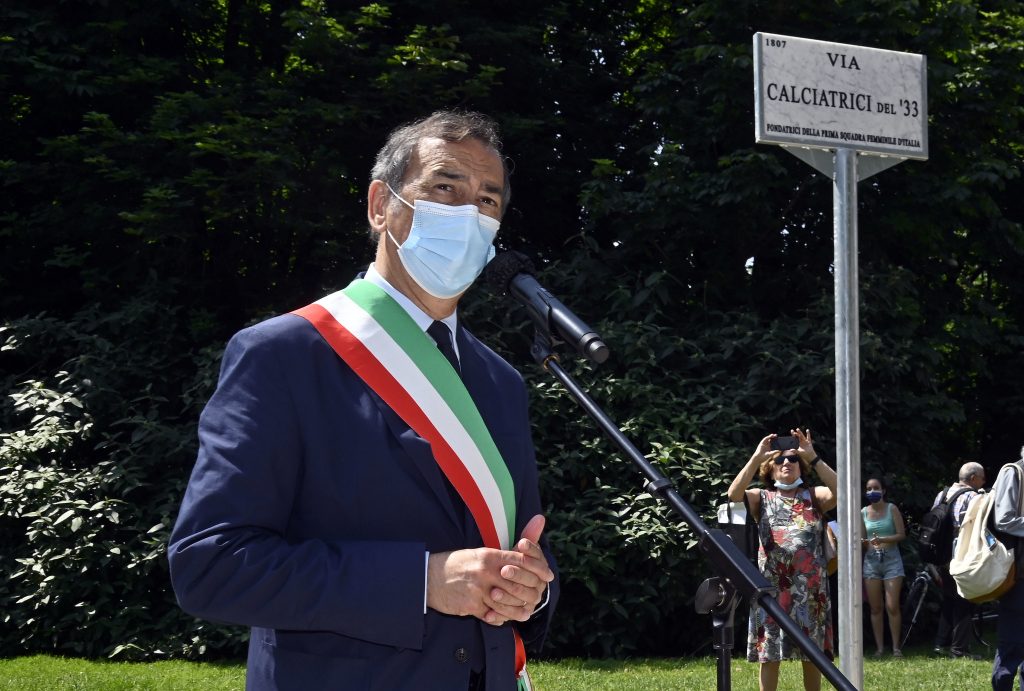
Mayor Beppe Sala speaking in front of the new street sign
Source: https://flic.kr/p/2m4ZTUh
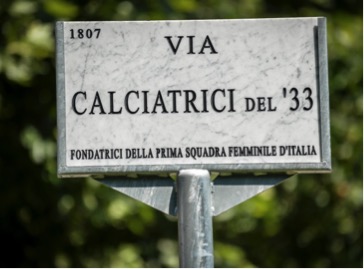
1933 Women’s Footballers Street | Founders of the first women’s team in Italy
Source: https://twitter.com/acmilan/status/1403721248841113608
A metal information plaque was erected, so that every passer-by could easily discover the basics of GFC history. In Italy, such public history installations devoted to Sports History are very rare!
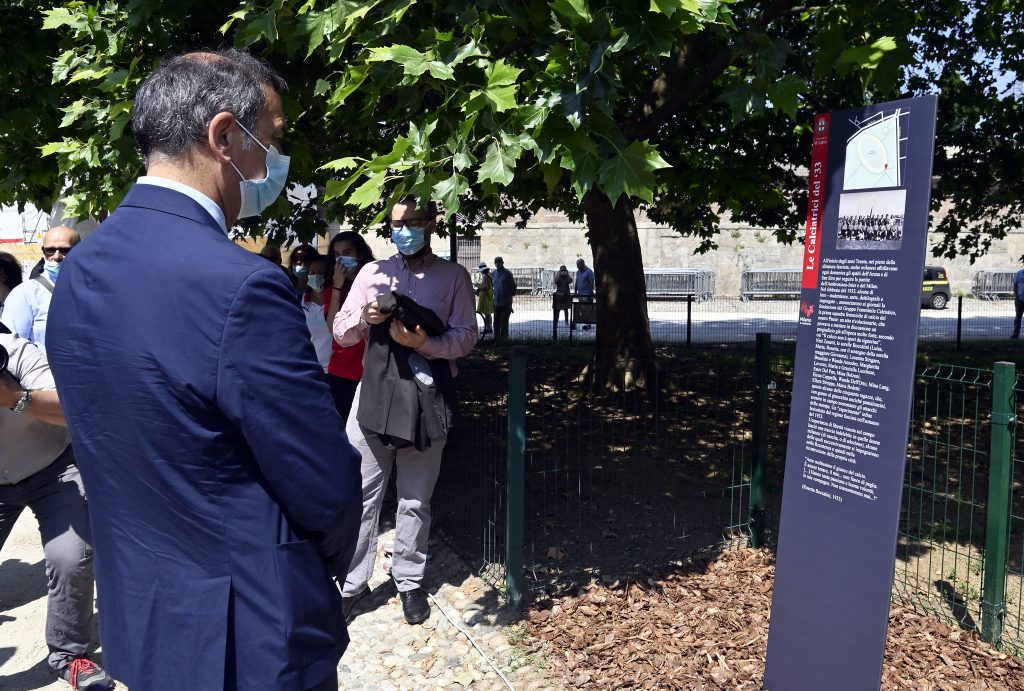
Mayor Sala reading the GFC on the metal plaque
Source: https://flic.kr/p/2m55z4H
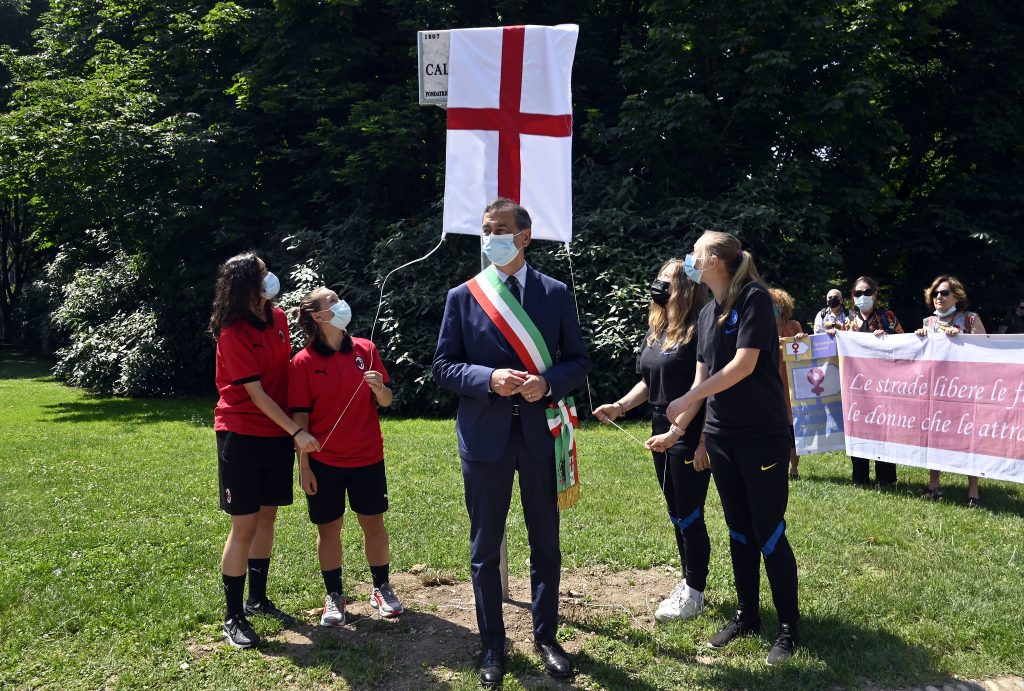
Because in 1933 the first female Italian footballers were for the most part teenagers, 2 AC Milan and 2 FC Internazionale youth team players had the honour to unveil the sign
Source: https://flic.kr/p/2m4ZTUY
Federica and I then each had the opportunity to give a short speech. I said:
What a wonderful milestone, after researching all these years. As Mayor Sala said, here in Milan we’re always working, with no time for our history, nor for the place of our history. It’s great that this story, which I began to bring to light some years ago, is becoming known: for a long time, it had been passed on in the silent houses of our city (and even outside of it). Grandmas, aunts, mothers went on telling it during mealtimes, maybe with the support of some old photos (such as the one that you can see now in the upper part of the plaque built by the Municipality).
The city of Milan, meanwhile, has forgotten this story, which took place on football fields that now no longer exist due to urban development. Luckily, the memories were somehow saved, and today are gaining a place in the city. We live in a world built by men: places, streets, squares never remember the female contribution to our history: the existence of this new street is therefore a good thing. The place is significant: the pitches where the calciatrici played don’t exist anymore, but the Arena Civica is still here. It was a significant place for them, they used to come here to attend the FC Ambrosiana-Inter matches (some of them went to San Siro Stadium to attend AC Milan matches). So we can say: here their passion was born: they come here to see Giuseppe Meazza and all his mates playing. Here their idea was born: “why don’t we do the same? why can’t we try? who’s going to stop us?”. Doing that, fighting against all prejudices, they started their adventure.
Milan, which was already at the forefront of the Italian sporting movement, hosted the first-ever women’s football team, and today is at the forefront of toponymy. It’s not only the first Italian city to name a street after a woman footballer, but also to do so in recognition of a women’s team. It’s very important because it removes the cliche of the single, heroic woman, fighting alone, and introduces us to the image of a collective fight: all those young women gathered together, coming from several families, from several experiences, in order to share something that ignited the spark in their hearts …»
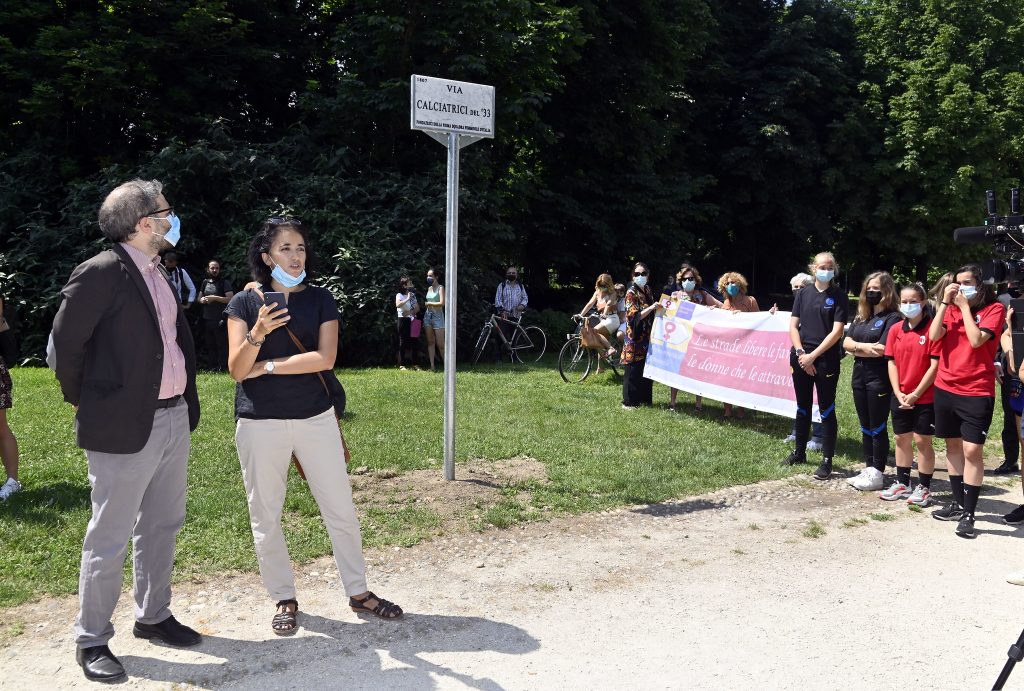
During Federica’s speech
Source: https://flic.kr/p/2m58tsh
During the last months, the research about GFC has continued. Thanks to sports journalist Luca Benedetto, who is writing a huge history of Unione Sportiva Milanese (once the third male football team in Milan, before the Fascist regime forced it to merge with FC Internazionale), we are now able to positively identify the 2nd GFC trainer, captured in a nice photograph with three Boccalini sisters, he is Umberto Marrè. During the 1920s’ he had been playing for FC Internazionale and US Milanese.
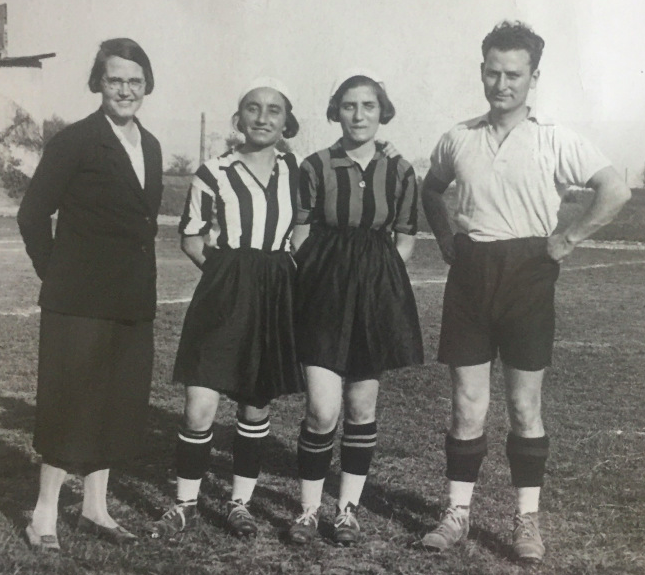
GFC team manager Giovanna Boccalini Barcellona; Luisa Boccalini; Rosetta Boccalini; trainer Umberto Marrè
Source: Archivio privato Giovanna Boccalini Barcellona
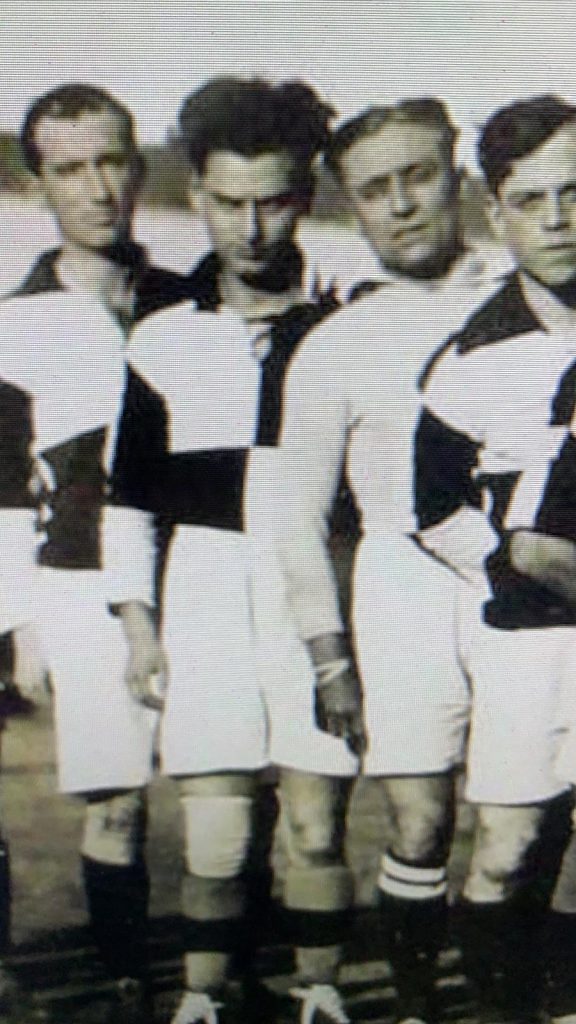
Umberto Marrè (2nd from the left) with his US Milanese team-mates [1924]
Image courtesy of Luca Dibenedetto.
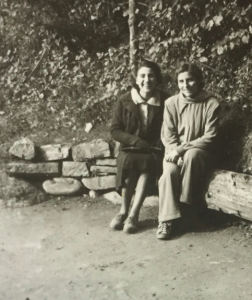
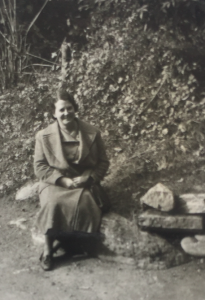
We already know about the first photo, depicting Rosetta as a basketball player (on the right) and her sister Marta. The discover of the second photo, depicting Giovanna, told us that both Marta and Rosetta went to Turin to support her sporting sister, in 1940.
Source: [1] Archivio privato Giovanna Boccalini Barcellona; [2] Archivio privato Marta Boccalini
Searching through all the photo albums and the letters to or by Marta, I saw a light-blue notebook, which looked to be very unremarkable. Still, there was something handwritten on the cover. I read:
“Boccalini Rosetta” … and then, “Calcio” ‘football’ …
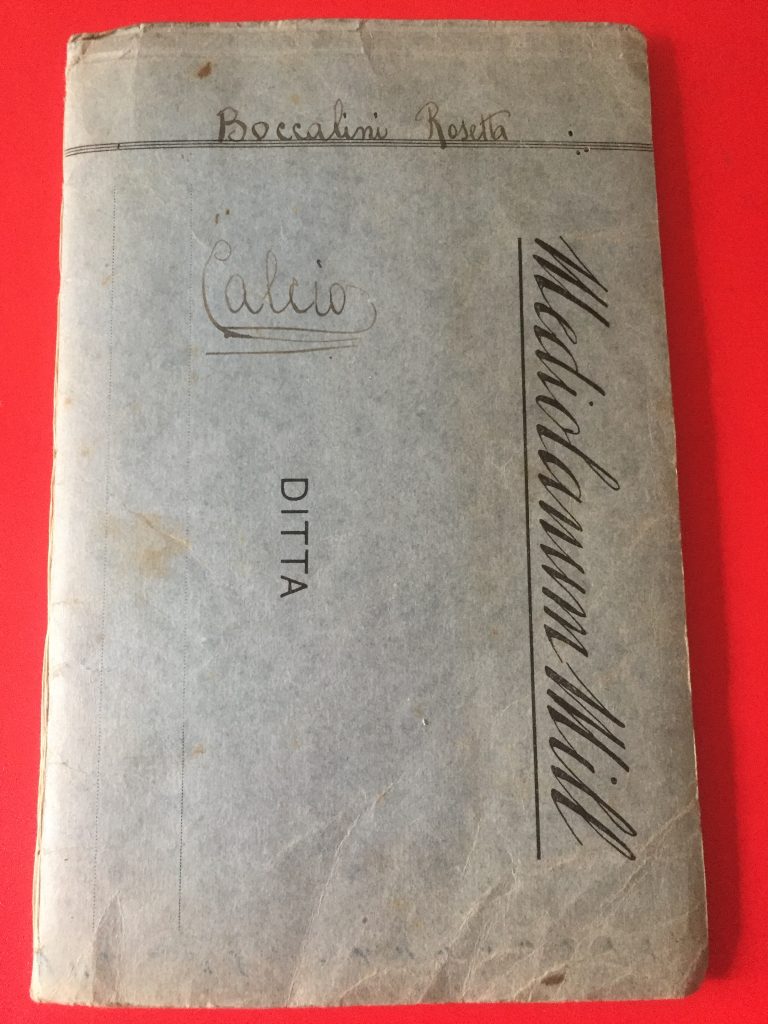
Rosetta’s football notebook, cover
It isn’t a diary, but a notebook in which the 17-years old Rosetta pasted the clippings about GFC, adding in her own hand the day of publication.
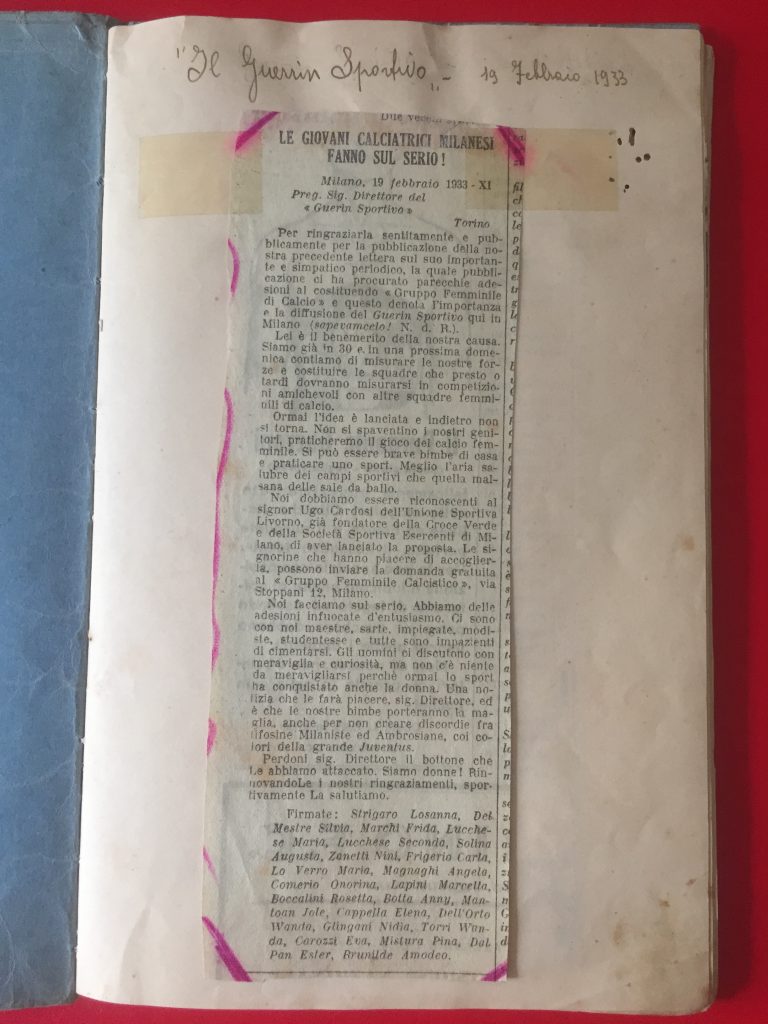

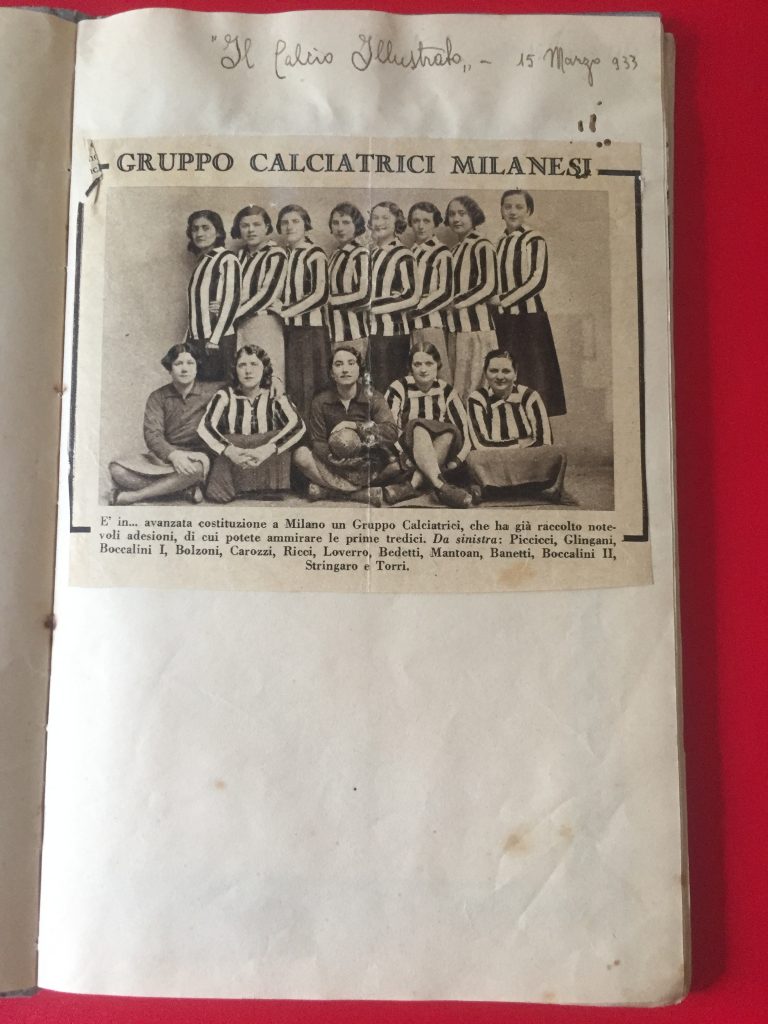
Rosetta’s football notebook, pp. 1-3
Since the few Italian journalists who in 1933 bothered to attend a GFC match (instead of writing about in their press-rooms) praised Rosetta as the best player, she underlined such sentences about herself, as any talented teenager would do …
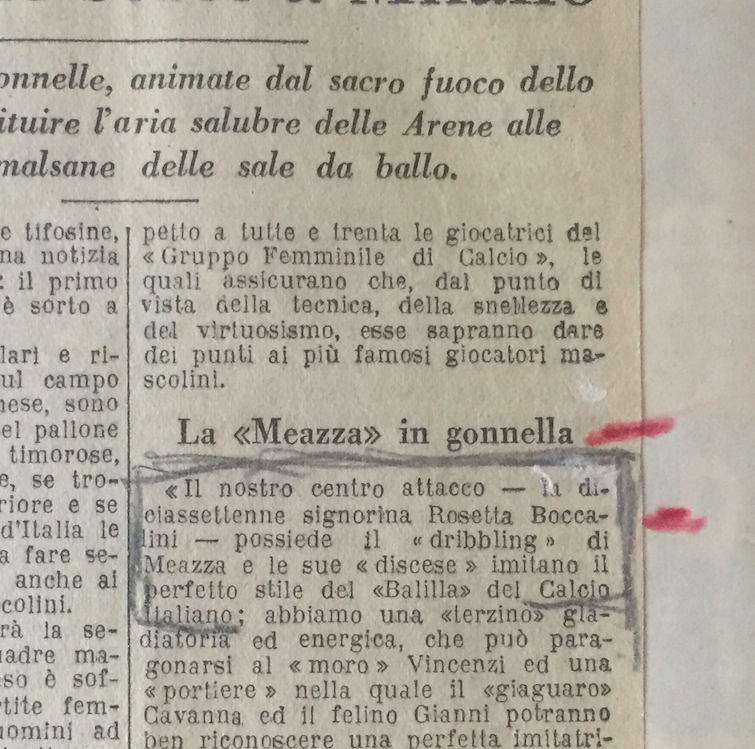
Rosetta’s football notebook, p. 4
The underlined sentence about ‘Meazza in a dress’, is quoting what Losanna Strigaro said to the Il Mattino journalist, it says:
Our centre-forward, the 17-years old Rosetta Boccalini got the Meazza’s dribbling, and her dribbling imitates the Balilla’s perfect style
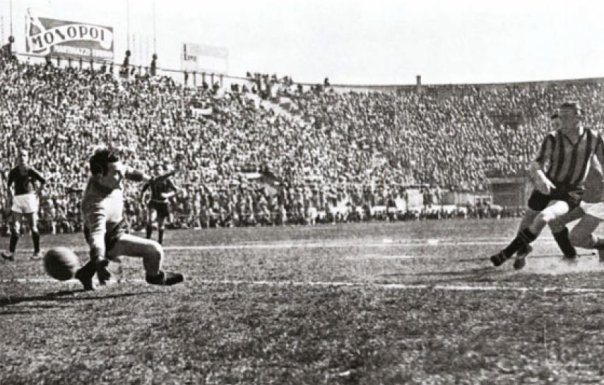
Thanks to his dribbling skills, Ambrosiana-Inter center-forward Giuseppe Meazza was able to score some fabulous individual goals
His nickname ‘Balilla’ (young boy belonging the Fascist Youth Association) was born because the first time he entered the Ambrosiana-Inter changing room, an older player mocked him for his very young age: ‘Now we even let the Balilla kids play with us!’
Source: http://www.giuseppemeazza.it/it/goal-a-invito-meazza
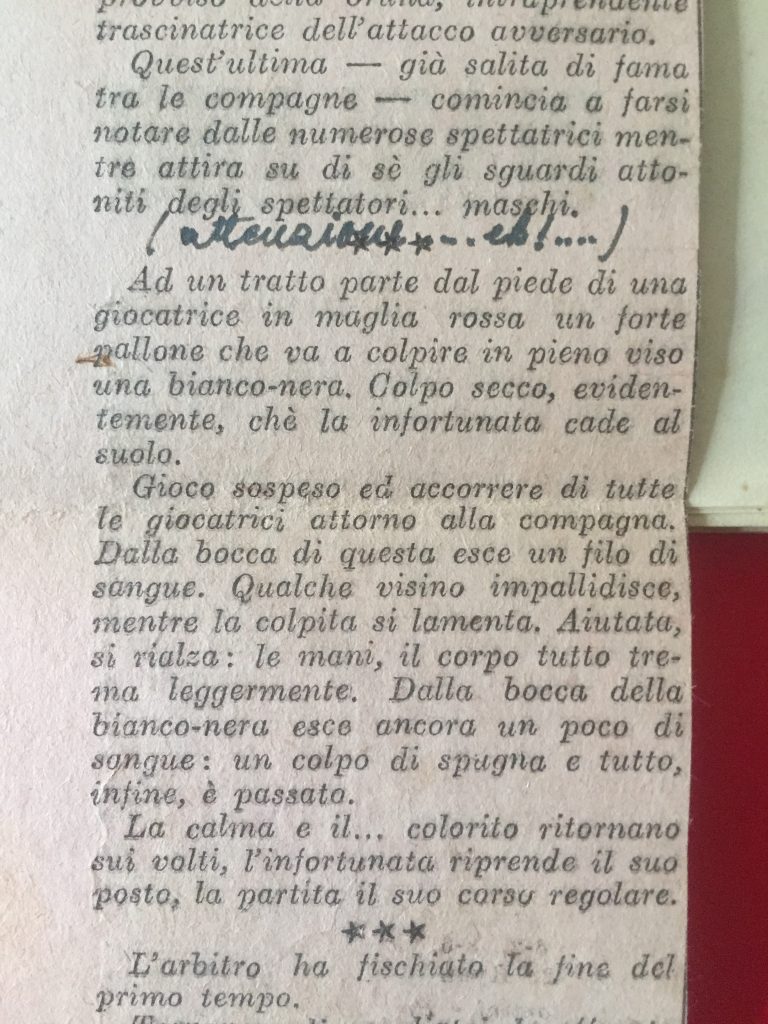
The Gazzetta dello Sport journalist wrote that Rosetta
‘who has already got the opportunity to grandstand among her mates, is now starting to prove herself to the female audience, and to draw the attention of the astonished male audience’
Rosetta comments: ‘Eh eh … Watch out!’
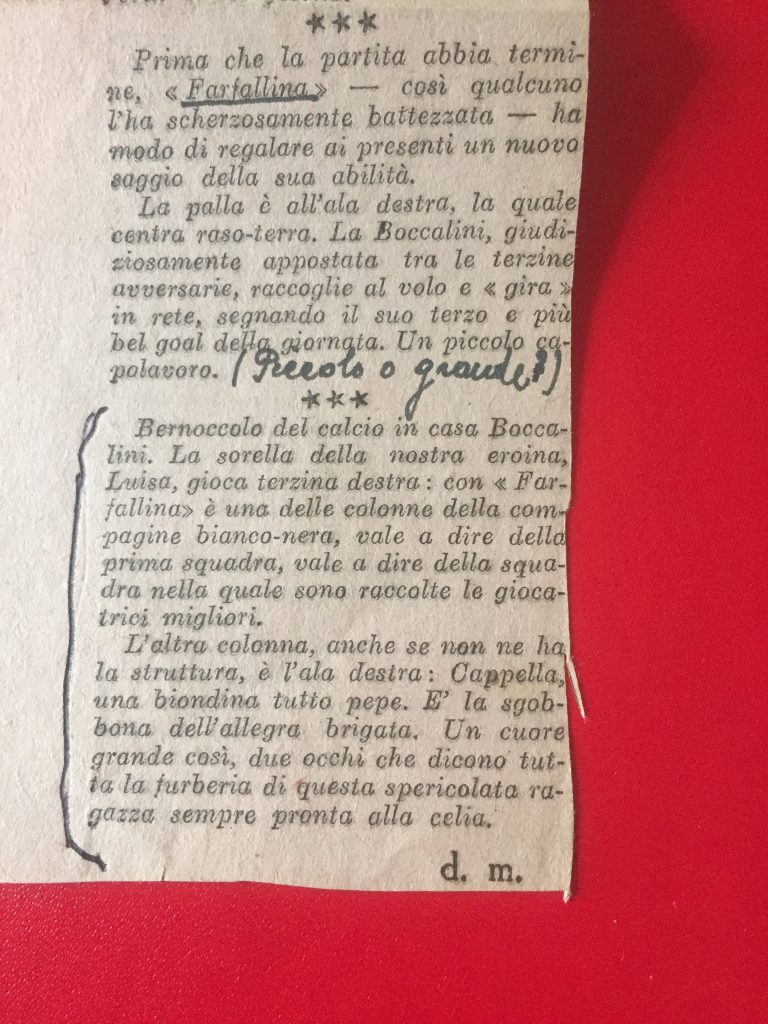
Rosetta underlines the last paragraph, where the Gazzetta dello Sport praises her sister Luisa, and their team-mate Elena Cappella
Before that, Rosetta underlines her new nickname, ‘Farfallina’, the female form of ‘Farfallino’
Then Rosetta comments on the passage where the journalist praises her third goal, describing it as ‘a little masterpiece’
She comments: ‘Little, or big?’
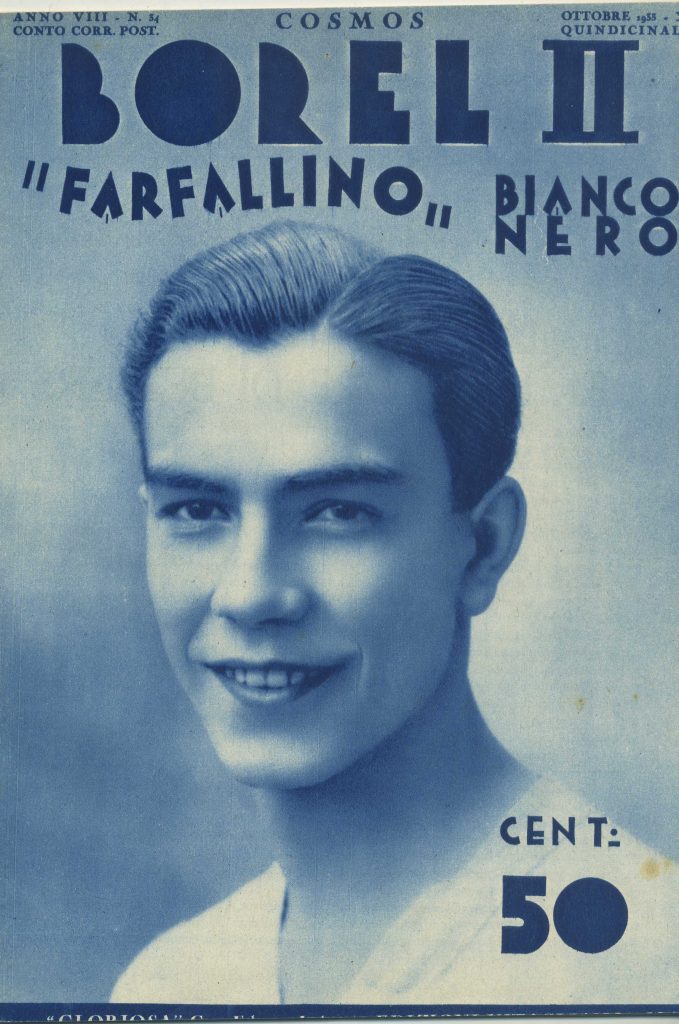
During the1932/1933 Serie A season, the new star was the young FC Juventus center-forward Felice Borel II
whose nickname was ‘Farfallino’ or the ‘little butterfly’
just 18 in his first season with FC Juventus he scored 29 goals in 28 matches!
Source: https://twitter.com/juventusfc/status/725610732147081216
Let’s say something about Rosetta’s notebook as a material object. Some clippings are glued (of course, some of them are now … free of glue …), while others are scotch-taped.
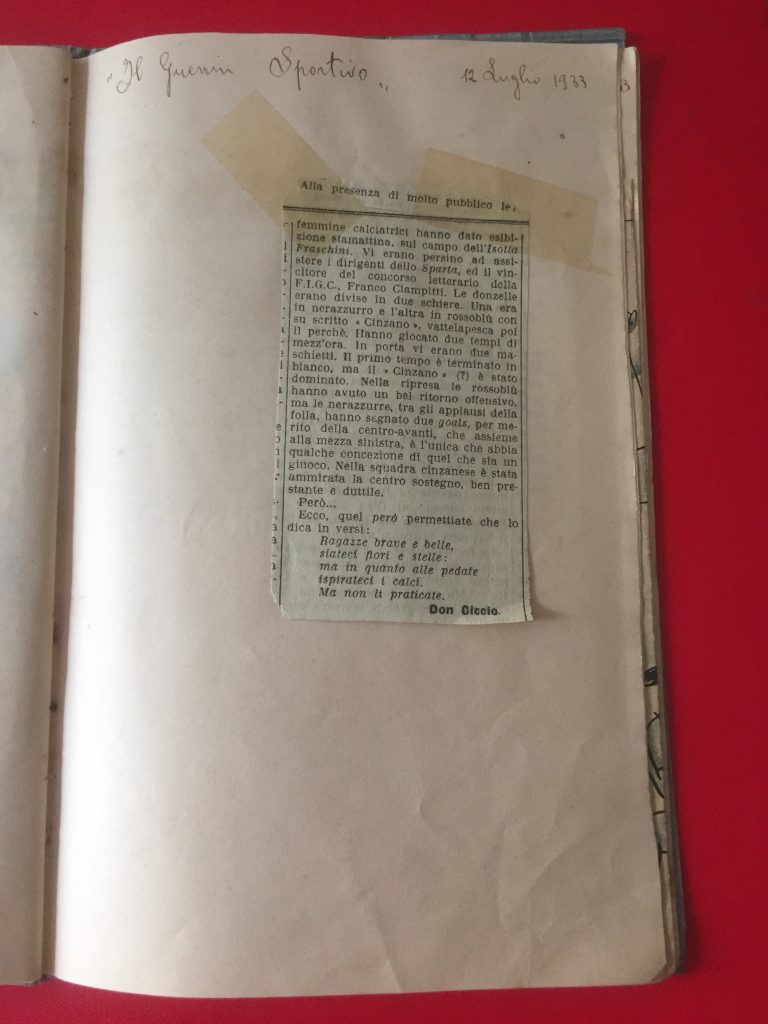
Rosetta’s football notebook, p. 20. A scotch-taped clipping.
For some time Rosetta’s notebook had been host to moths! The right-upper part of all the first pages are moth-eaten: the same problem has also affected the folded parts of the clippings.
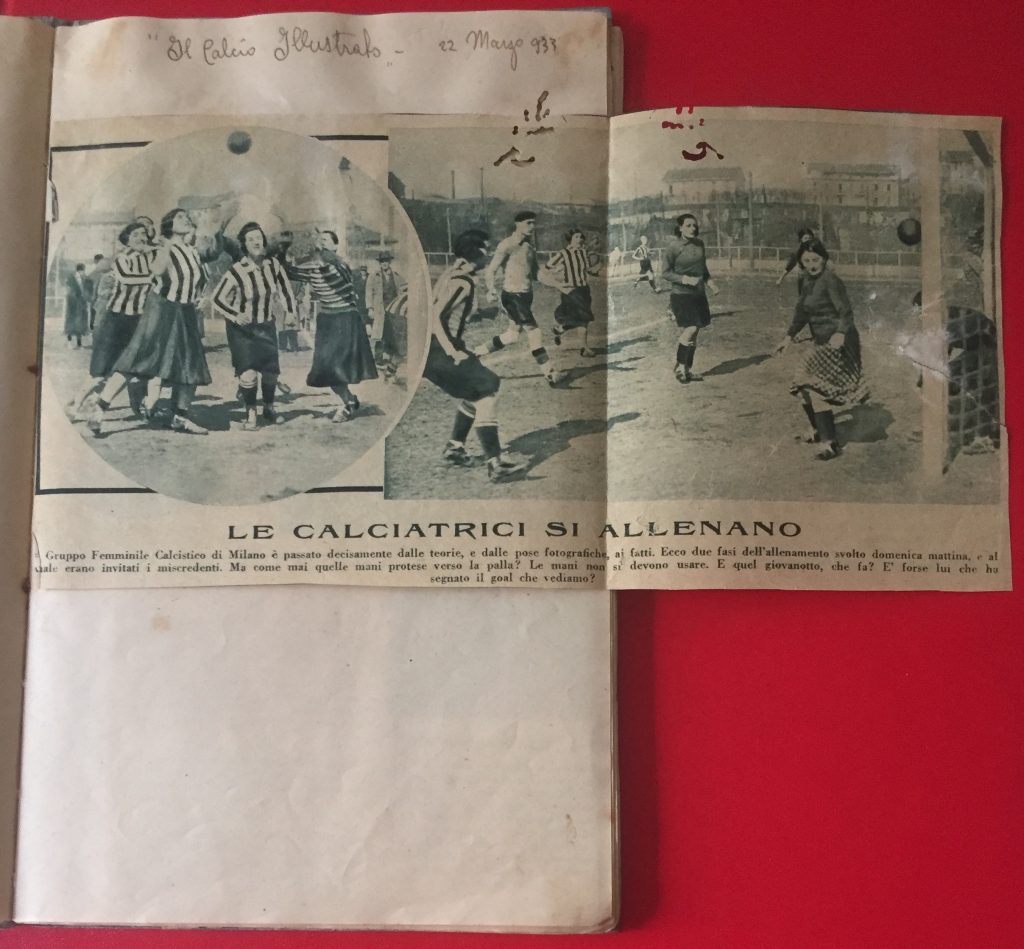
Rosetta’s football notebook, p. 5.
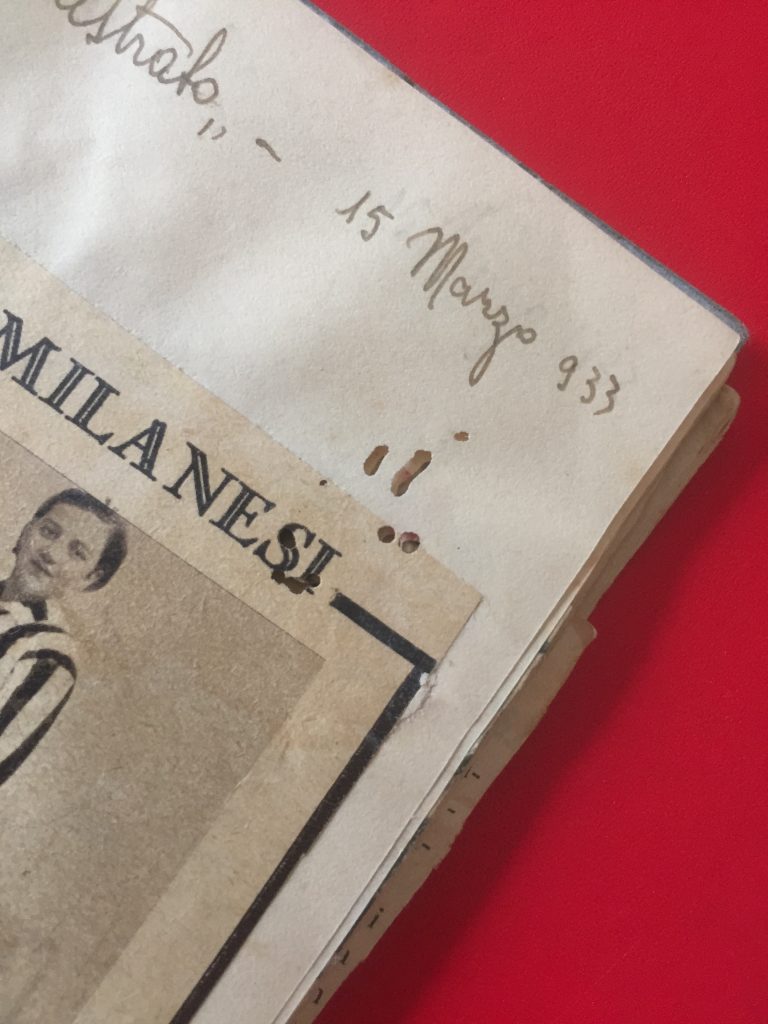
A detailed of the moth-eaten part of Rosetta’s football notebook, p. 3.
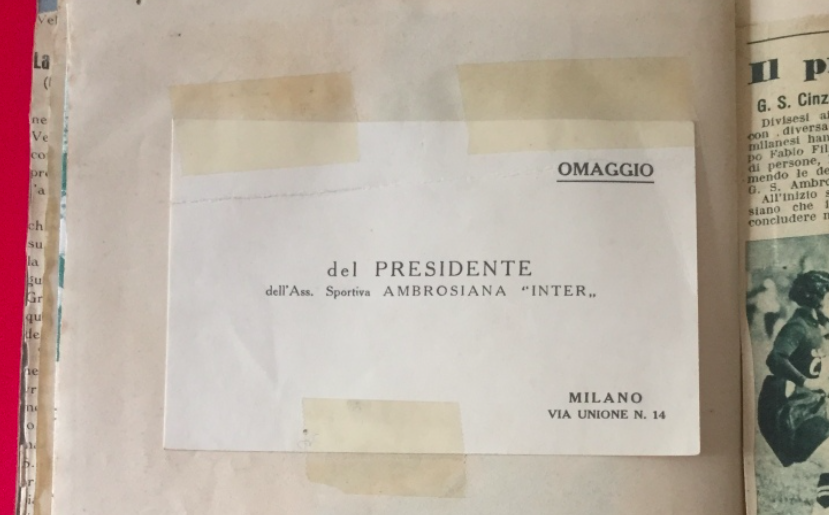
Rosetta’s football notebook, p. 18. It’s a complimentary ticket signed by Fernando Pozzani, President of both male football and female basketball FC Ambrosiana-Inter club
(see https://www.playingpasts.co.uk/articles/football/and-then-we-were-boycotted-new-discoveries-about-the-birth-of-womens-football-in-italy-1933-part-7/ )
Might it be the free ticket the Czech captain Burgr gave to Rosetta to attend Ambrosiana – Sparta Praha football match on 9th July 1933, after watching the young women playing
(see https://www.playingpasts.co.uk/articles/football/and-then-we-were-boycotted-new-discoveries-about-the-birth-of-womens-football-in-italy-1933/ )?
The last glued clipping is the famous and beautiful photo gallery published by Il Calcio Illustrato on 26th July 1933, in which the young women are reading the newspaper during their holidays, waiting for the beginning of the next season, in September. Then something happend – the boycotting by the Fascist regime, as we can see from the fact that the last clipping, dated 8th October, is not even glued or scotch-taped …
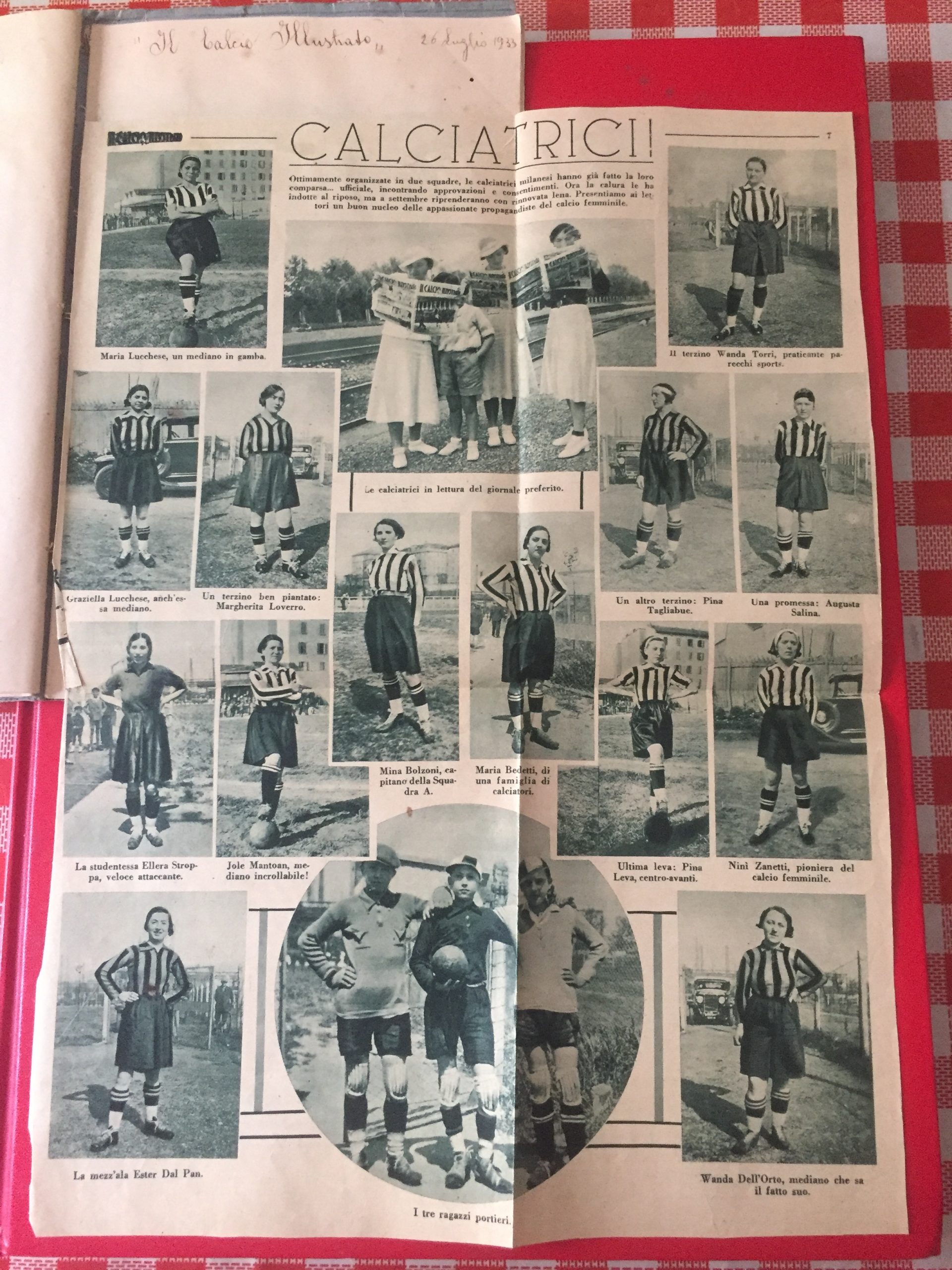
Rosetta’s football notebook, p. 23.
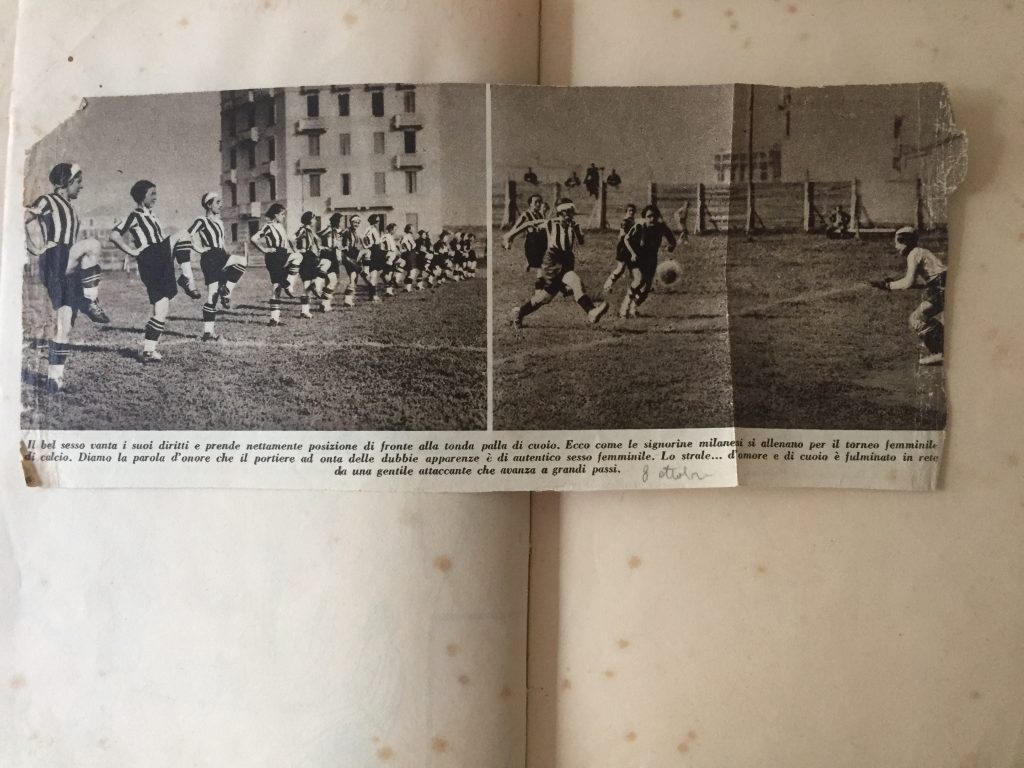
Rosetta’s football notebook, p. 24.
In Rosetta’s football notebook there are also 2 documents referring to her next sporting career as a basketball player (see https://www.playingpasts.co.uk/articles/football/and-then-we-were-boycotted-new-discoveries-about-the-birth-of-womens-football-in-italy-1933-part-7/ ): they are both dated 1948, that is her last year as captain of the Ambrosiana team, with which she had won three National championships (1938-1940). The second is a clipping about the last match of the 1948 season: Bernocchi Legnano defeated Ambrosiana, winning its second consecutive National title. The first is an interesting letter by Ambrosiana manager Enrico Leone to Rosetta, written after he noticed the captain’s behaviour during the match Comense – Ambrosiana 25 – 26. Leone praises how Rosetta as captain was able to motivate her team-mates during the half-time, reminded them of the love and pride for the Ambrosiana club. So, after an avoidable defeat against Indomita Rome club (19-22, in Milan), the Ambrosiana players were able to gain a “beatiful victory” following the boisterous audience of the Como pitch. After all those years, the 32 years-old captain, who had dreamt of becoming the Meazza in a dress during her juvenile years, found her place.
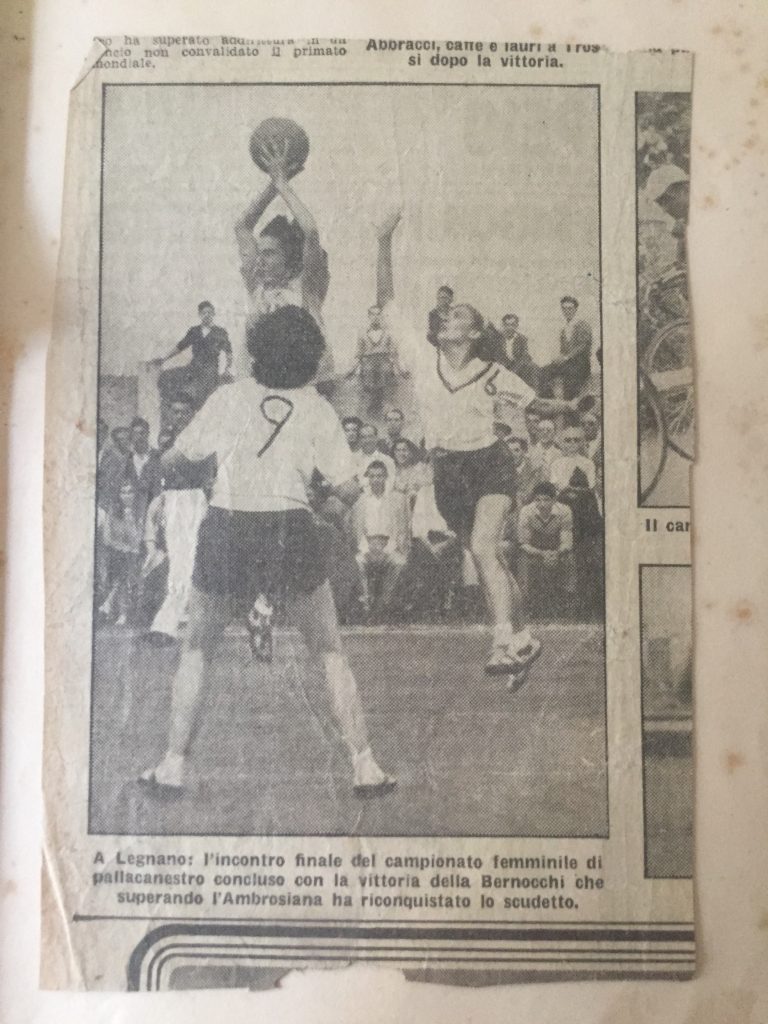
The basketball clipping about Bernocchi Legnano – Ambrosiana match.
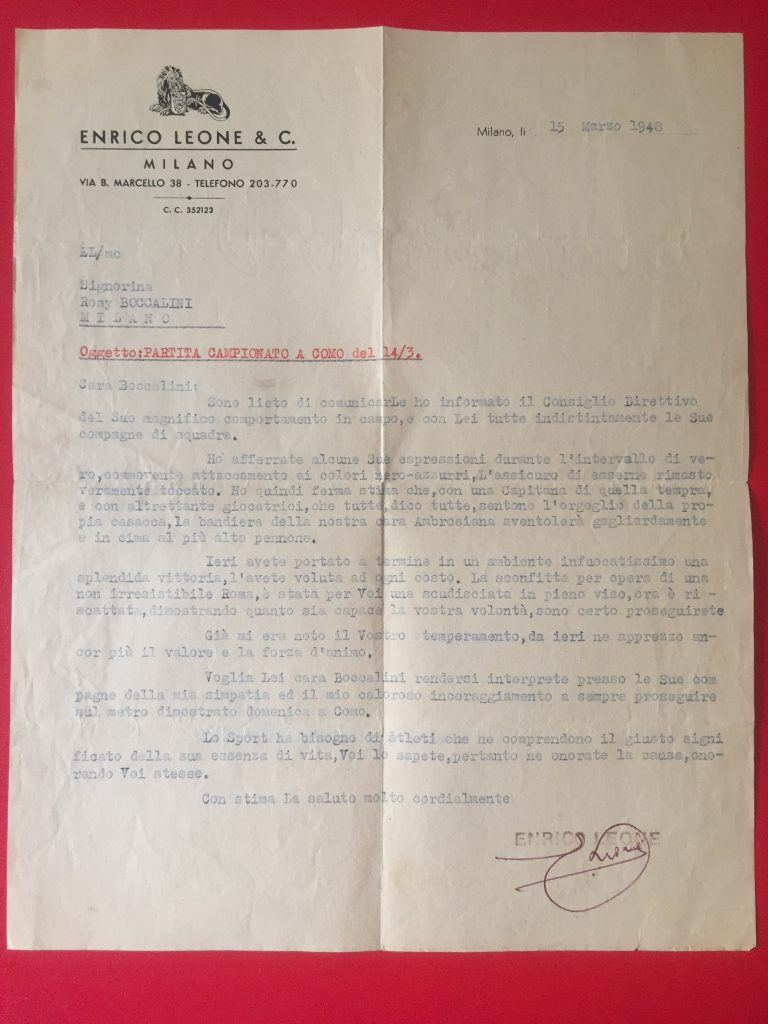
Enrico Leone’s letter to Rosetta Boccalini, from Milan, 15th March 1948.
I already knew about most of the clipping, having already collected them from several Italian libraries: yet I missed some of them, because during 1930s’ there were a lot of sports newspapers, some of them having a local distribution, or even a short editorial life. What do these new clippings teach us about the history of GFC?
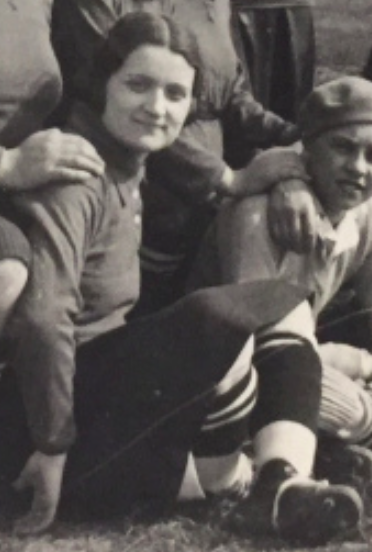
Losanna Strigaro as a Team B calciatrice
Source: Archivio privato Brunella Bracardi.
First of all, there’s an article published by Il Piccolo Sport on 19th February, written by a journalist whose nickname was “Felix”. After reading about the birth of GFC, he decided to visit via Stoppani 12, the address from which the aspirants of the calciatrici ‘women footballers’ would write. So Felix met Losanna Strigaro, clerk at Ugo Cardosi wine shop and Secretary of GFC, described as
a beautiful girl, blonde, slender, perky: the perfect one to put on practice as it should be done the brave project
Then a very interesting description of Losanna’s office room:
a real sporting nest. Walls plastered with football photos, several sports journals and an issue about Meazza’s life prove how the young lady is a huge tifosina ‘football fan’
Further sources inform us that for most part the calciatrici were Ambrosiana-Inter fans, yet there were also supporters of Milan (such as Carla Frigerio), Livorno (the city from which Cardosi family came) and Bari (at least a pair of calciatrici came from the Puglia region).
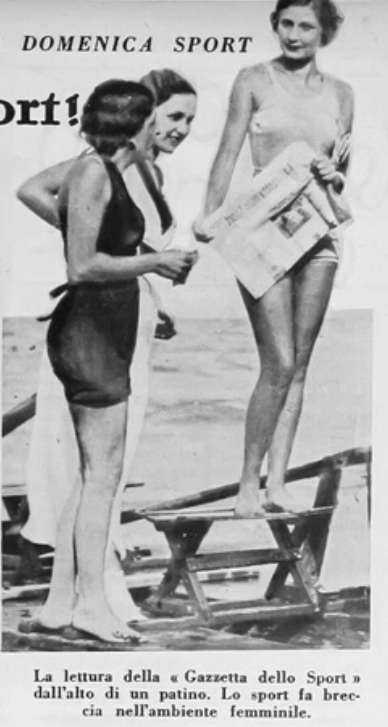
Three tifosine reading La Gazzetta Dello Sport on the beach
Source: La Domenica Sportiva, 13/08/1933, p. 6
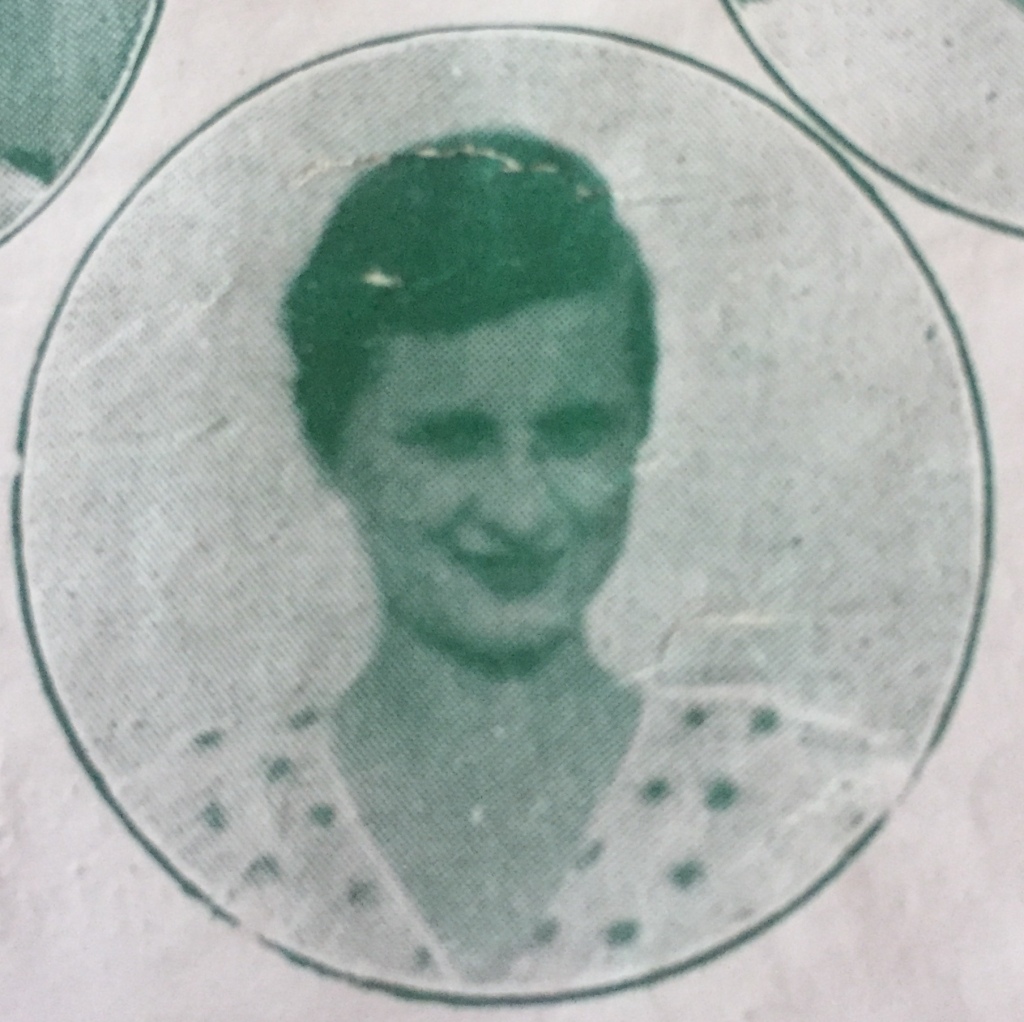
The AC Milan fan Carla Frigerio
Source: L’Antenna Sportiva, 01/06/1933
“Felix” help us to better understand the birth of GFC, and the main role played by Losanna Strigaro. Just like her friend Ninì Zanetti, Losanna wondered why Italian girls, already accustomed to all kind of sports, couldn’t play football. Then, during the holidays in Tuscan village Castiglioncello (see https://www.playingpasts.co.uk/articles/football/playing-in-heeled-shoes-in-milan-and-winning-olympic-medals-in-london-some-new-discoveries-about-the-pioneers-of-italian-womens-football/ ) in Summer 1932, Losanna and other 10 female friends tried to play against 11 male players. It was just a leisure activity, very similar to those which we still play during our holidays. Nevertheless, Losanna thought that women’s football could be a very good idea: she talked about that with her Ambrosiana fan colleagues, and then to her boss, Mr. Ugo Cardosi, who agreed to funding his employee’s team.


A tifosina among male football fans at the stadium
Source: La Donna, Maggio 1933, pp. 26-27
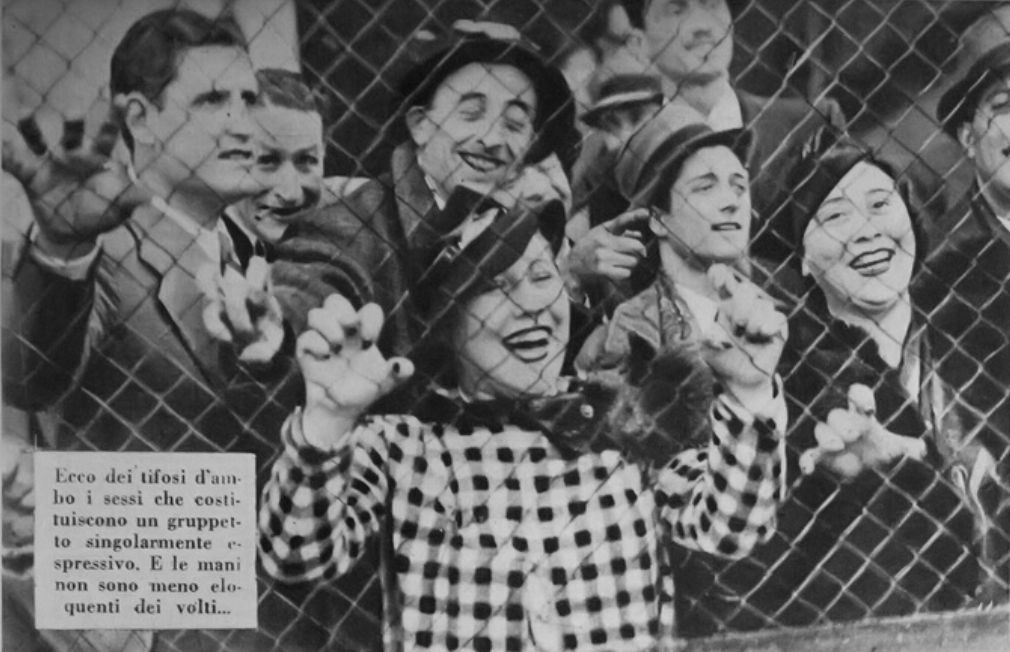
Male and female supporters together in a late 1930s’ Italian stadium
Source: Il Calcio Illustrato, 6 aprile 1938, p. 9.
Thanks to a Piero Cardosi photograph and to a new journalistic source we can now know that during the GFC training matches the male trainer played with the girls, in order to improve their game.
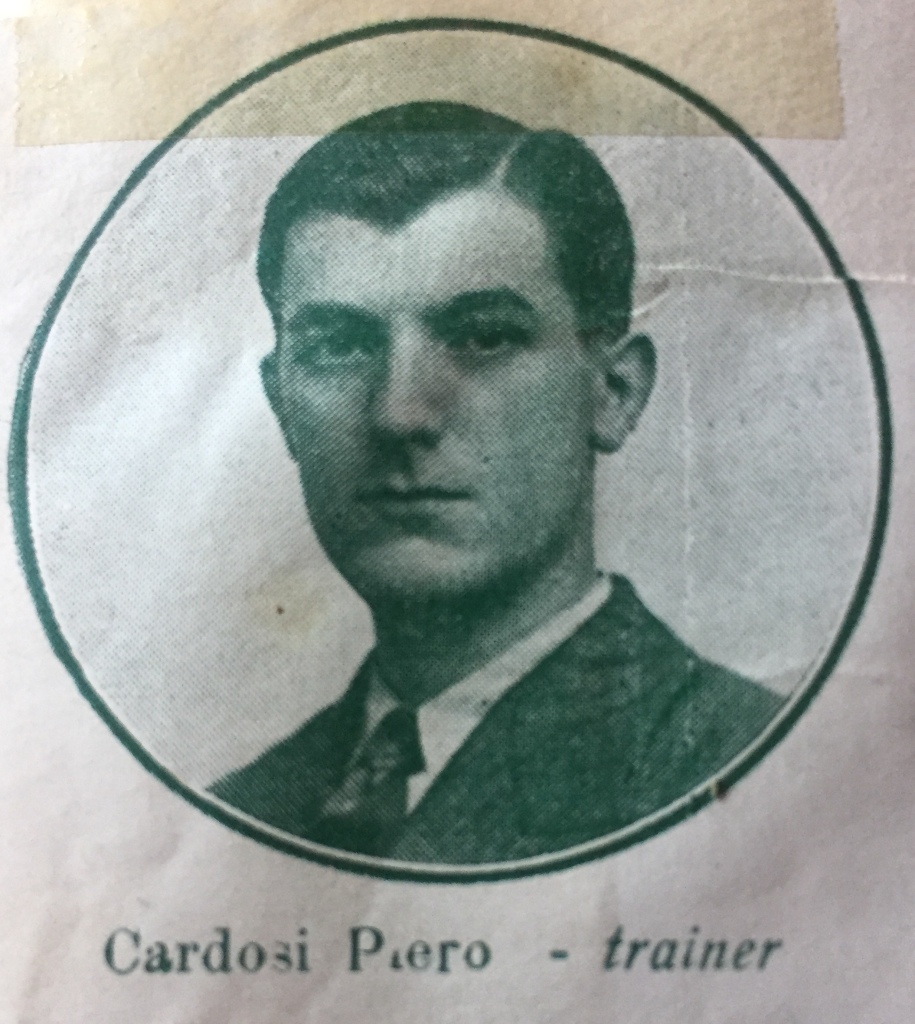
Piero Cardosi. Despite the appearance, he was only 23-years old!
Source: L’Antenna Sportiva, 01/06/1933
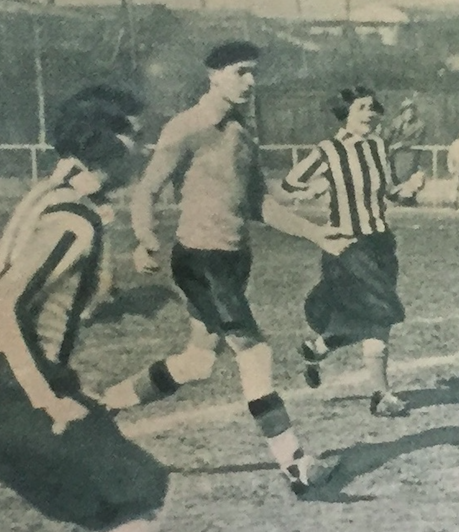
Piero Cardosi playing among the calciatrici; probably he’s wearing his amateur team (AC Littoria) socks
Source: Il Calcio Illustrato, 22/03/ 1933, p. 16
What about the first two kits? All sources says that the first (black-and-white striped shirts) and the second (garnet shirts) were chosen because they were the same as FC Juventus and FC Torino’s ones – so Ambrosiana-Inter and AC Milan wouldn’t argue about that. But during an interview by Il Mattino journalist, Luisa Boccalini confessed that there was one further practical reason: blank, white and garnet/red are the cheaper and more resistant colours!
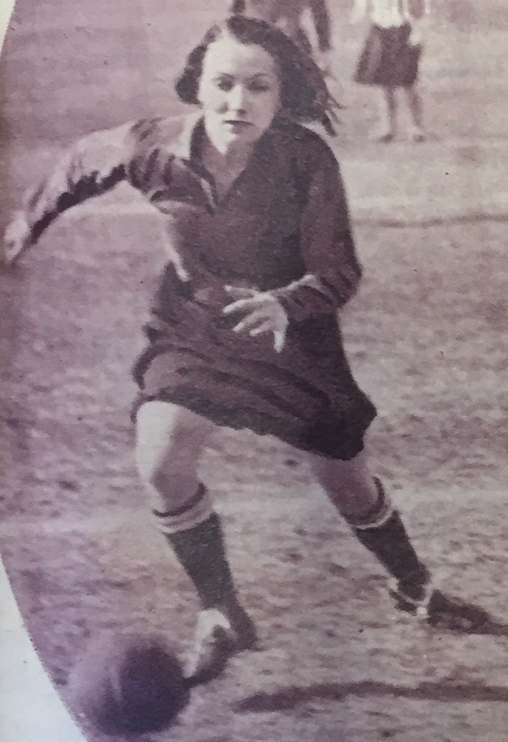
A garnet team player: we didn’t at first know her name …
Source: Il Calcio Illustrato, 29/03/1933, p. 11
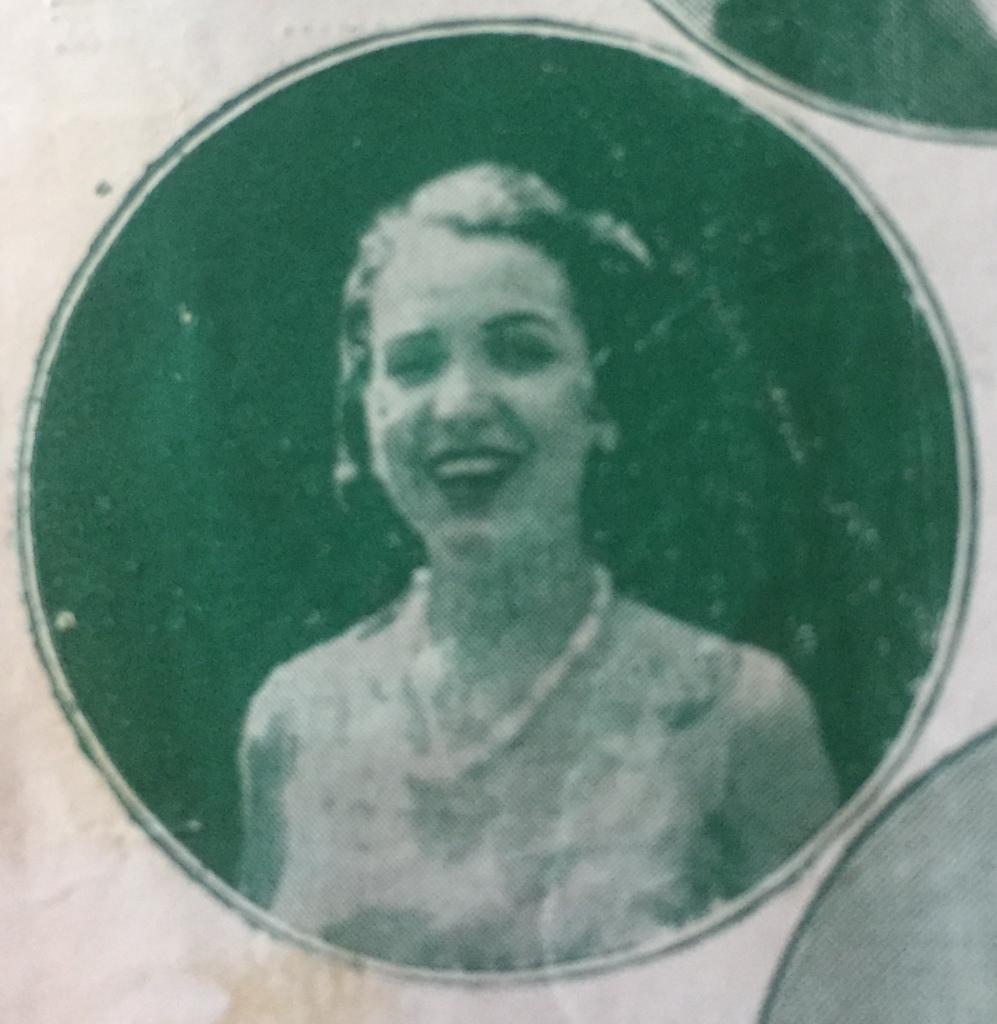
Her name was “Glingani B.”: probably the sister, or the cousin of GFC player Nidia Glingani
Source: L’Antenna Sportiva, 01/06/1933.
The last new document is a letter written by Ugo Cardosi to L’Antenna Sportiva, in reply to an article written against women’s football. Writing in early August, some weeks before the boycotting storm which would destroy his beloved GFC project, Cardosi defended with every weapon his calciatrici had, underlining i.e. that they don’t play men’s football, but a special feminine form of it, or that no girl got injured. In some passages, Cardosi seems to wink at the regime and its idealized donna nuova ‘new woman’: the calciatrici are brave and wealthy girls who don’t waste their time in pubs and cafès. Most surprisingly, Cardosi suggests that if only the Italian Olympic Committee (CONI) hadn’t decided to forbid any female presence at the 1932 Summer Olympics in Los Angeles, maybe Italy would be able to overtake the US in the medal table … Twist of fate, the absence of women’s football in the 1936 Olympic Programme was going to be used by the new CONI President, Achille Starace, to boycott the sport in Fascist Italy…
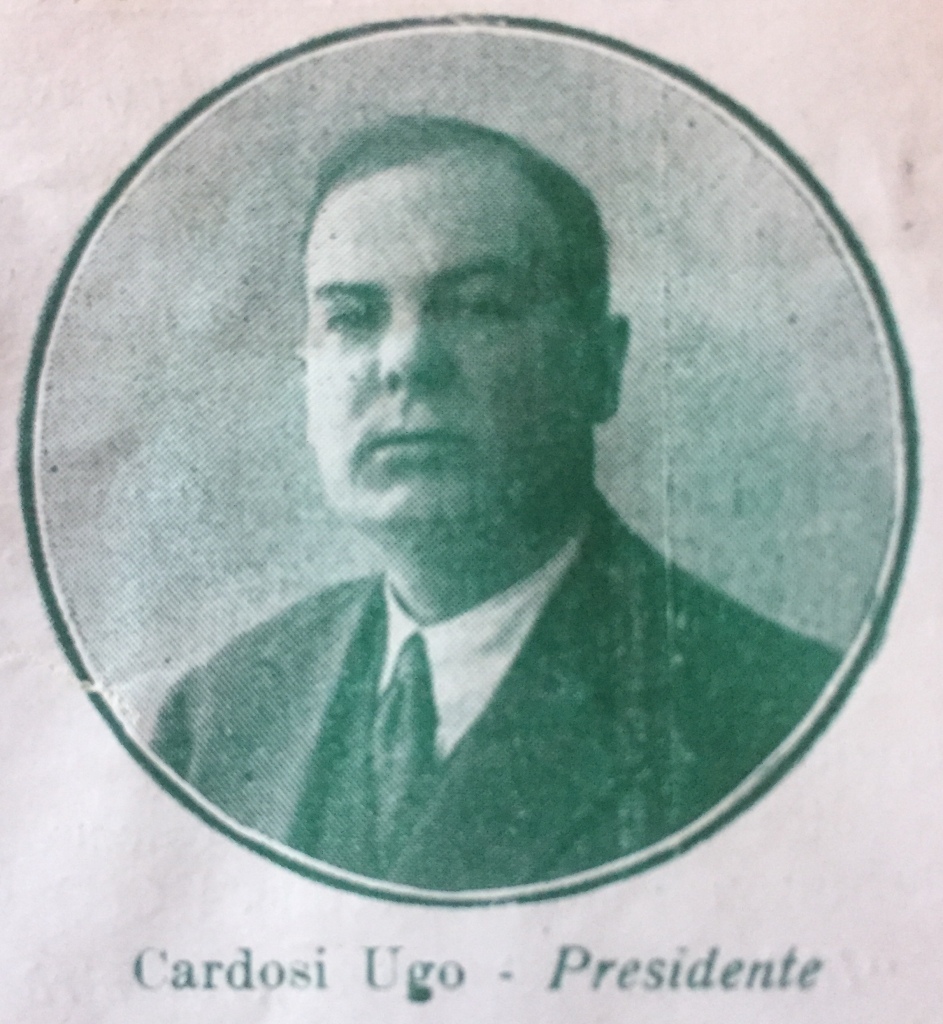
Ugo Cardosi, GFC President
Source: L’Antenna Sportiva, 01/06/ 1933
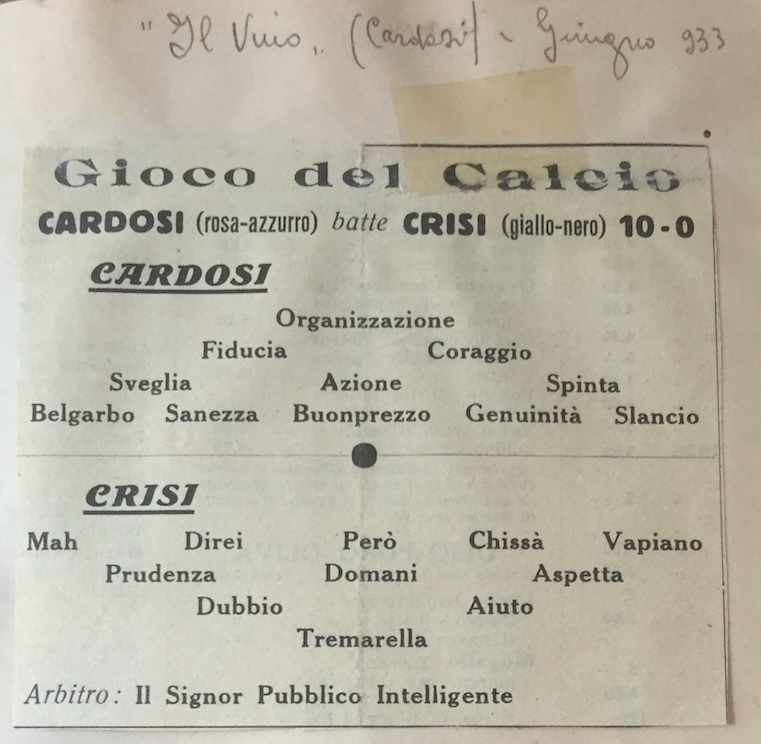
The wine & vermouth trader Ugo Cardosi was also the publisher of a little wine magazine, called ‘Il Vino’
here’s a clipping from Rosetta’s football notebook
Cardosi team is depicted as defeating the Crisis team thanks to players such as “Confidence”, “Courage”, “Genuineness” …
Article © of Marco Giani
For further photos about the Via Calciatrici del ’33 inauguration, see:
https://www.flickr.com/photos/comune_milano/albums/72157719402982091/
For the complete edition of Rosetta’s football notebook, see:
https://sorelleboccalini.wordpress.com/extra_gfc_il-quaderno-del-calcio-di-rosetta/
For the updated GFC players’ photo gallery, see:
https://sorelleboccalini.wordpress.com/extra_gfc_la-galleria-delle-calciatrici/

![“And then we were Boycotted”<br>New Discoveries about the Birth of Women’s Football in Italy [1933] <br> Part 11](https://www.playingpasts.co.uk/wp-content/uploads/2021/07/Boycotted-Marco-Part-11.jpg)


